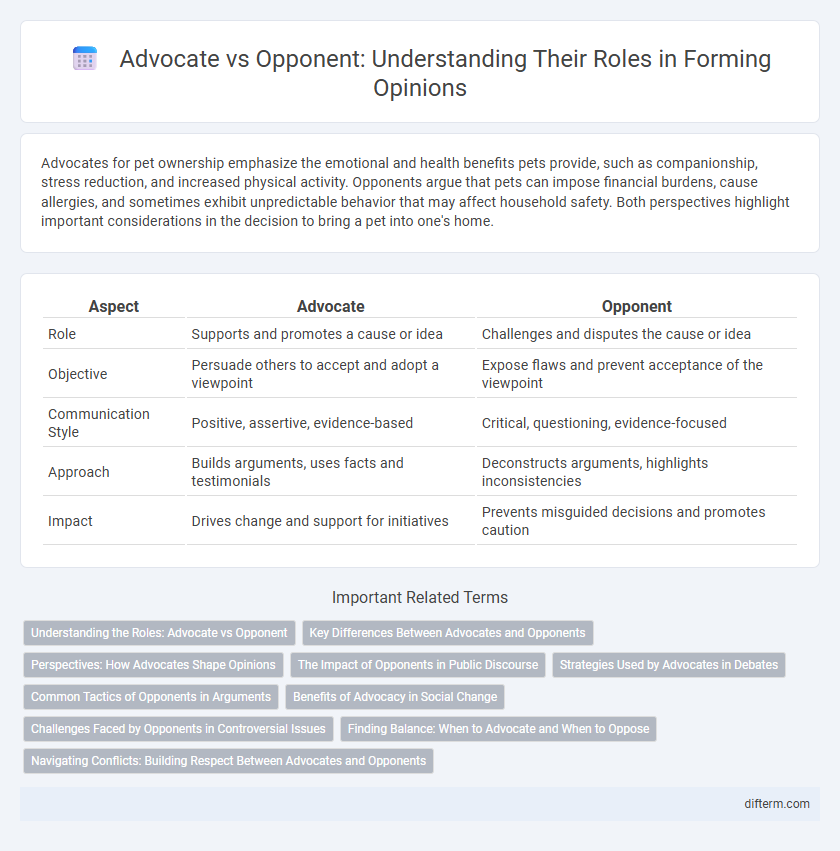Advocates for pet ownership emphasize the emotional and health benefits pets provide, such as companionship, stress reduction, and increased physical activity. Opponents argue that pets can impose financial burdens, cause allergies, and sometimes exhibit unpredictable behavior that may affect household safety. Both perspectives highlight important considerations in the decision to bring a pet into one's home.
Table of Comparison
| Aspect | Advocate | Opponent |
|---|---|---|
| Role | Supports and promotes a cause or idea | Challenges and disputes the cause or idea |
| Objective | Persuade others to accept and adopt a viewpoint | Expose flaws and prevent acceptance of the viewpoint |
| Communication Style | Positive, assertive, evidence-based | Critical, questioning, evidence-focused |
| Approach | Builds arguments, uses facts and testimonials | Deconstructs arguments, highlights inconsistencies |
| Impact | Drives change and support for initiatives | Prevents misguided decisions and promotes caution |
Understanding the Roles: Advocate vs Opponent
An advocate promotes and supports a specific cause or viewpoint, aiming to influence opinions and drive positive change. An opponent challenges these ideas, raising critical questions and presenting alternative perspectives to ensure balanced evaluation. Understanding these roles reveals how dialogue advances through constructive support and necessary skepticism.
Key Differences Between Advocates and Opponents
Advocates actively support specific causes or policies by promoting awareness and influencing public opinion, while opponents challenge or resist these initiatives by presenting counterarguments and highlighting potential drawbacks. Advocates often utilize persuasive communication and mobilize resources to achieve change, contrasting with opponents who focus on defending existing conditions or proposing alternative solutions. The key difference lies in their roles: advocates seek progression through endorsement, whereas opponents aim to prevent or modify actions through critique.
Perspectives: How Advocates Shape Opinions
Advocates shape opinions by presenting compelling narratives that align with their audience's values and emotions, often reinforcing existing beliefs or inspiring change. They utilize persuasive language, credible evidence, and relatable examples to establish trust and authority, effectively influencing public perception. By framing issues strategically, advocates can highlight benefits and minimize drawbacks, swaying undecided individuals and solidifying support.
The Impact of Opponents in Public Discourse
Opponents play a critical role in shaping public discourse by challenging prevailing ideas and prompting deeper analysis, which strengthens democratic debate. Their perspectives introduce diversity in viewpoints, fostering critical thinking and preventing groupthink within society. By questioning dominant narratives, opponents ensure accountability and drive social progress through constructive confrontation.
Strategies Used by Advocates in Debates
Advocates in debates employ well-researched evidence, emotional appeals, and clear logical reasoning to strengthen their positions and persuade audiences. They use rhetorical techniques such as analogies, repetition, and confident body language to enhance credibility and engagement. Effective advocates also anticipate opposing arguments, preparing counterpoints to maintain control over the narrative and influence decision-making.
Common Tactics of Opponents in Arguments
Opponents in arguments frequently rely on tactics such as straw man fallacies, misrepresenting the advocate's position to weaken their credibility. They often employ ad hominem attacks, targeting the advocate personally rather than addressing the argument's substance. Another common strategy is shifting the burden of proof, forcing advocates to disprove false claims instead of providing evidence for their own stance.
Benefits of Advocacy in Social Change
Advocates play a crucial role in driving social change by raising awareness, influencing policy, and mobilizing communities to address systemic issues. Through persistent efforts, advocacy champions amplify marginalized voices and create pressure for equitable reforms. This proactive engagement fosters inclusivity and accelerates progress toward social justice goals.
Challenges Faced by Opponents in Controversial Issues
Opponents in controversial issues often encounter significant challenges such as social ostracism, misinformation campaigns, and emotional backlash that hinder their ability to present dissenting views effectively. They must navigate deeply entrenched biases and fear of retribution, which limits open dialogue and polarizes public opinion. These barriers complicate the pursuit of balanced discourse and the resolution of complex societal debates.
Finding Balance: When to Advocate and When to Oppose
Advocating effectively requires identifying issues where positive change is possible and public support aligns with ethical considerations, while opposing is crucial when policies threaten fundamental rights or evidence shows detrimental impacts. Finding balance involves assessing the strength of arguments, potential outcomes, and the broader social context to decide when to assert influence or resist initiatives. Strategic advocacy and opposition ensure that efforts contribute constructively to discourse and policy development without polarizing or impeding progress.
Navigating Conflicts: Building Respect Between Advocates and Opponents
Navigating conflicts between advocates and opponents requires active listening and empathy to foster mutual understanding. Emphasizing shared values and common goals can reduce hostilities and build respect despite differing viewpoints. Constructive dialogue creates opportunities for collaborative problem-solving and long-term cooperation.
advocate vs opponent Infographic

 difterm.com
difterm.com